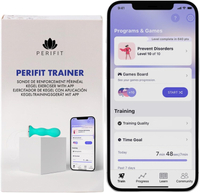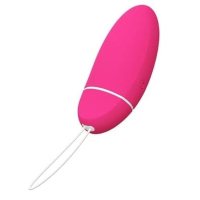How to use a pelvic floor trainer - with tips from the experts on getting the most from your device
Wondering how to use a pelvic floor trainer? Whether you have a mechanical or manual device, here's what the experts want you to know with step-by-step instructions

Wondering how to use a pelvic floor trainer? Whether you have a mechanical device like an Elvie or Perifit, or a manual device like kegel balls, this expert-approved, step-by-step guide will take you through what you need to know.
As we get older and go through perimenopause, many women find that their pelvic floor muscles, which sit across the pelvis and support the reproductive organs, weaken thanks to the natural drop in oestrogen levels that come with menopause. Using one of the best pelvic floor trainers with exercises can be a good way to strengthen and stretch this band of muscles, reducing the chance of negative side effects like a loss of bladder and bowel control with age, and improving vaginal health.
As well as strengthening the muscles, some trainers can release tension. Pelvic floor rehabilitation specialist Simone Muller says this is a condition where the pelvic floor muscles are overly tight called hypertonic pelvic floor. It can cause constipation or bladder urgency and have an impact on your sex life.
Only by learning how to use a pelvic floor trainer correctly can you benefit from these trainers as you still have to do the kegel exercises most of the time. Whether you have a manual device or a mechanical trainer, we've got you covered. Here, woman&home speaks to several women's health physicians and pelvic floor experts to reveal how to use a pelvic floor trainer.
How to use a pelvic floor trainer
Manual pelvic floor trainers
A manual pelvic floor trainer is a weighted ball or cone that you insert into your vagina, squeeze and release with your pelvic floor muscles. Research from the likes of the University of Jaén has shown that it's a highly effective way to strengthen your pelvic floor muscles, alleviating stress incontinence and other issues among women. Some manual floor trainers come as a singular weight while others come in packs of two or more.
"You hold the weights in place using your pelvic floor muscles and, when you can, you progress to the next one, which weighs more," says Dr Hana Patel, a GP and women's health specialist.
To learn how to use kegel balls, you need to know how to do kegel exercises:
- Insert the weighted ball or cone as far as you're comfortable: The removal string or loop should be visible outside of your vagina.
- Relax and take a few breaths: Give yourself time to get used to the weight as it may feel unusual if you're not used to the sensation.
- Close your anus: Without clenching, as if you're trying to stop yourself from passing wind.
- Squeeze your vaginal muscles at the same time: Like you would if you were trying to stop yourself from urinating. Avoid pulling in your stomach, however.
- Hold both in this position: Try to hold the muscles in this position for 12 seconds.
- Relax: Slowly let the muscles relax, pausing for 5 seconds when relaxed.
- Repeat: Aim for three sets a day or as many as comfortable - but avoid overworking the muscles, as this can cause tightening.

One of our top picks: Kegel8 pelvic floor balls. These three differently-weighted balls can be used progressively to strengthen your pelvic floor. A great choice for total beginners, the set offers biofeedback with unique indication from the tail to tell you when you're doing the exercises right.

As kegel balls sit among the best sex toys as well as being pelvic floor trainers - if used in the right way - it would make sense that Lovehoney sells some of the best. These 74g weights are sleek silicone, making them comfortable to insert and remove with lubricant. No feedback, so this is a set for those already comfortable with kegel exercises.

Not sure whether manual or mechanical pelvic floor trainers are for you yet? Don't spend a fortune with this set, available from Amazon from 13AM. There are four interchangeable weights (46g, 73g, 11g) housed in two choices of soft silicone holders, for under £15 at the time of writing.
Mechanical pelvic floor trainers
While manual pelvic floor trainers have been around for centuries, mechanical ones are newer on the market. Technology is improving constantly, and these are designed to help make kegel exercises easier - mainly by guiding you through the process. Some advanced devices will almost do them for you with medically-approved electrical currents.
"The app can monitor your progress and set different workouts," says Dr Shirin Lakhani, an aesthetic physician and intimate health expert. "The app will most likely lead you through a series of exercises and workouts that are usually five to 10 minutes long."
Here, we look at three favourites: the Elvie pelvic floor trainer, the Perifit pelvic floor trainer, and the Intimina KegelSmart 2. Each of these offers biofeedback on your workout, revealing the intensity of your contractions and the rate of progress. They will tell you if you're doing the exercises correctly too, so they are great options for beginners and those struggling with the technique.
How to use the Elvie pelvic floor trainer
- Connect your device to the app.
- Stand up or lie down with your legs shoulder width-apart.
- Hold the Elvie trainer where the round part meets the tail and gently insert it into your vagina opening until the pod and about 1cm of the tail is inside you.
- Try the device with and without the cover to see which is more comfortable for you.
- Begin the exercises as instructed on the app.
Elvie recommend exercising in the same position each time to get consistent results, so always start your pelvic floor workout either lying down or standing with your feet shoulder width apart.
Elvie Pelvic Floor Trainer: £149.99 from John Lewis
Elvie helps you visualise your pelvic floor movements, using real-time biofeedback to help improve your exercises. Workouts are based around five-minute gamified exercises that include a combination of six different exercise types, with options for all ability levels.
How to use the Perifit pelvic floor trainer
- Insert the trainer so just the pull handle is accessible.
- Start the app to ensure you’ve inserted it correctly and choose the right training program.
- If it’s your first time using it, you can use the training mode to ensure the correct technique.
- Choose a game to occupy and motivate you while you do the exercises.
- Make sure you relax after each contraction for at least five seconds so your muscles aren’t overstimulated.
- Stop when the app tells you to stop - after around 10 minutes.
The Perifit trainer is a little different to the other pelvic floor trainers - it allows you to play games on your smartphone, controlled by the device and your pelvic floor muscles, to make the exercises less monotonous.
The product has a unique patented double pressure-sensor technology that can tell you if you’re doing the contractions wrong. It will also tell you when to stop and relax so you can avoid muscle fatigue or hypertonicity.
Perifit Pelvic Floor Trainer: £129 at Amazon
The Perifit pelvic floor trainer is one of the favourites for good reason. This device uses patented technology and fun exercises to help you work your pelvic floor. App in hand, you have seven specific programs to choose from that target specific needs and problem areas.
How to use the Intimina KegelSmart 2
- Press the button on the side of the device to turn it on. The first time you use it your muscle tone will be assessed.
- Insert the device into your vagina like a tampon, leaving the cord visible outside your vagina.
- There are three short vibrations to tell you it’s about to start and then a five-minute routine will begin.
- In this routine, you tighten your pelvic floor muscles when you feel the vibrations and then relax when they stop.
- At the end of the routine, the device will vibrate three times and then switch itself off.
The Intimina KegelSmart trainer is a rechargeable device which doesn’t come with an app but is still very efficient at strengthening your pelvic floor muscles. It uses touch sensors to measure your pelvic muscle tone and picks the most suitable training program from five levels.
Intimina KegelSmart 2 Pelvic Floor Trainer: £89.90 at Amazon
5 progressive levels are included in the Intimina KegelSmart 2 pelvic floor trainer. It's one of the only mechanical devices worth buying that comes without an associated app, offering a hands-free option for those new to pelvic floor training.
How often should I use a pelvic floor trainer?
Each device will have recommendations for how often you should use it, so consult the instruction manual if you're using a mechanical device. For example, Elvie suggests using their device three times a week for five minutes a day for better pelvic floor strength, control, and confidence in just four weeks.
Perifit goes even more specific with three to five 10-minute sessions every week and Intimina suggests using their device every day for five minutes, gradually moving through the levels as your pelvic floor strength increases.
The manual trainers also recommend around five to 10 minutes of training every day.
How long should I use a pelvic floor trainer for?
Many people find they begin to see results with their pelvic floor trainer within six to 12 weeks of first using the device. Like all muscles in your body, your pelvic floor muscles may lose strength and flexibility if they’re not trained consistently. Once you have reached a strength level you’re happy with, try to maintain it by continuing your exercises.
Sarah Scudamore, who runs pelvic floor workshops and is the founder of Mumology Movement, says as women age their muscle mass continues to reduce and the laxity can increase. This, combined with a drop in oestrogen during menopause, is why it’s important to keep up with the exercises and not to neglect this important area of your body.
Tips for using your pelvic floor trainer
- Clean your device regularly: Clean it regularly and thoroughly to prevent infection and irritation - but never use cleansers containing alcohol, petrol or acetone as these can interfere with your body’s natural balance and also damage the device. Instead, use a body-friendly antibacterial soap or spray to clean your device and leave it to air dry.
- Take advantage of the advanced features: If the device comes with an app, use it to keep track of your progress and to check you’re performing the exercises correctly. Some devices take a while to get used to but an app can reveal personalised tips and how-tos to make pelvic floor exercises easier for you.
- Remain consistent: Even if you find the pelvic floor exercises difficult, try to stick with them. "Remain consistent with these exercises to see real and lasting improvement," says Dr Lakhani.
- Use a lubricant for easier entry: Most people will find that using a lube makes inserting their device more comfortable. Use a water-based one rather than silicone and if you need a suggestion, try our round-up of the best lubes.
- Store your device safely: Safe storage of your pelvic floor trainer is important to keep all the pieces together and continue with constant use. If you'd rather keep your device hidden away, you can take a look at our tips on how to store sex toys, since these are in the same category of device.

Kat Storr has been a digital journalist for over 15 years after starting her career at Sky News, where she covered everything from world events to royal babies and celebrity deaths. After going freelance eight years ago, she now focuses on women's health and fitness content, writing across a range of UK publications.
From perimenopause to the latest fitness trends, Kat loves researching and writing about it all. She's happy to give any fitness challenge a go and speaks to experts about wellbeing issues affecting people every day.



